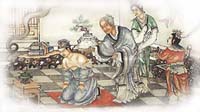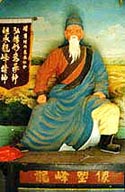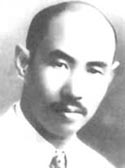
| Home | |||
| About Us | |||
| Overview | |||
| Shaolin | |||
| Hsing Yi | |||
| Philosophy | |||
| Practice | |||
| References | |||
| Tai Chi | |||
| Bagua | |||
| Baji | |||
| Health | |||
| Other Styles | |||
|
|
|||
| Links | |||
| Directory | |||
| News | |||
he exact history and origin of Xinyi Quan is unclear. As with most martial arts, there are many myths and legendary figures that played important roles in the organization and promotion of Xingyi Quan, and General Yueh Fei is usually credited as the founder of this style. Yueh Fei himself attributed his skills to a wandering Taoist, his teacher, who had no traceable name. Other, rarely acknowledged, influences in the development and the history of this style are the Shaolin temple, various family styles and other general, regional martial arts. The basic history for Xingyi is summarized in four periods spanning nearly one thousand years.
1. Prehistory -1100's, Intention Fist, Yueh Fei 2. 1600's, Heart Intention and Six Combinations Fist, Ji Jike, Cao Ji Wu 3. 1800's, XingYi Quan (Shape and Intention boxing). Three styles: Henan, Shanxi and Heibei , Li Nengran and his students 4. 1930's +, Additional New styles - Yi Chuan (Intention boxing), Da Cheng Quan (Great achievement fist), Wang Xiang Zhai
eneral Yueh Fei was one of China's greatest generals from the Song Dynasty. To most Chinese, he embodied all the patriotic and martial spirit of a patriot and national hero. Most scholars agree, however, that there is insufficient proof that General Yueh actually invented the art of Xingyi. In martial arts circles, he is given the credit as the founder of many different styles of martial arts including: Eagle claw and the health exercise known as the "Eight Pieces of Brocade". He is often given credit because of his accomplishments and his critical role in Chinese history. What is generally accepted is his proficiencies in the martial arts and the training he provided to his troops that resulted in his military successes.
This picture describes a popular story concerning Yueh Fei and his mother. Before Yueh Fei went to battle for the first time, his mother wrote on his back the words "Jin Zhong Bao Guo" (Be Loyal and Protect the country).
Popular writings suggest that Yeuh Fei taught "Xin Yi Liu He Quan" (Heart Mind Six Harmonies Boxing) to his army and attribute many Xingyi writings to him. The Six Harmonies refer to the Three Internal Harmonies (the heart or desire coordinates with the intent; the intent coordinates with the qi or vital energy; the qi coordinates with the strength), and the Three External Harmonies (the shoulders coordinate with the hips; the elbows coordinate with the knees and the hands coordinate with the feet).
One of the earliest references to Yueh Fei in boxing lore is in the "Preface to Six Harmonies Boxing" (Liuhequan Xu) written in 1750. According to this treatise, the style was created by Yue Fei who "as a child learnt from a master of deep knowledge and became very skillful at spear play; (on this basis) he created a boxing method to teach his officers and called it "Intention Boxing" (Yi Quan); (the martial art was) marvelous and ingenious, unlike any other before. After the King (e.g. Yue Fei) (passed away), the art was rarely seen during the Jin, Yuan and Ming dynasties."
Some indications of the validity of this claim can be found in recent research. One current Chinese martial arts magazine published an article about a discovery of a new branch of Xinyiquan, related neither to the Moslems nor to the Dai Family. The style is practiced only in a very small community in a small village in Henan Province. This article conveyed many facts that seem to support the thesis that the style is a "living remains" of Yue Fei's boxing from before the time of Ji Longfeng. For example - one of the rules of that style does not allow to pass the boxing technique to people with the last name Qin - probably because Yue Fei was betrayed (which resulted in a death sentence) by Qin Hui, a minister in the Song court. The style shows some similarity to other Xinyi branches, but its movements are simple; the neigong methodology (internal exercises) is practically nonexistent, and emphasis is put on practical fighting skills.
Ji Jike (Ji Longfeng, 1602-1683)
i Jike, also known as Ji Longfeng , lived at the end of the Ming and the beginning of the Qing dynasties (1600's). He was born and lived at Zhufeng of Pudong (today's Village Zuncun in Yongji County, Shanxi Province). He began his classical studies when he was seven years old, and Wushu training at 13. After sitting for the imperial examination, he passed with honors, which earned him a position as a court official in Shanxi. He was disillusioned in this position because of the corruption he encountered, and was eventually forced out of office. After leaving, he decided to travel throughout China to refine his martial arts. Some books suggest that he spent more than 10 years in the Shaolin temple to study Shaolin Wushu, and that he later taught in the region. During this time, he was suspected of being involved in the anti-Qing movements.
Legend suggests that Ji Jike went to the Zhongnan (Jong Nan) Mountains to visit teachers having a profound knowledge and that he received the boxing manual of King Wumu (Yue Fei) entitled "The Bible of Six Harmony Quan". This cannot be confirmed, but Yueh Fei represented a respected and legendary figure whose spirit was well admired at that time and could be used as a symbol for Jike's anti Qing activities.According to the "Ji Clan Chronicles" (Ji Shi Jiapu), Ji Longfeng's spear skill was extraordinary and he was known as "Divine Spear" (Shen Qiang). From those manuals and using spear principles, he taught a new style of fighting in Henan. He is recorded as stating "I have protected myself in violent times with my spear. Now that we are in a time of "peace" and our weapons have all been destroyed, if I am unarmed and meet the unexpected, how shall I defend myself?" In answer to his own question, Ji Longfeng reportedly created a style of unarmed combat based on his expertise with the spear. He referred to his art as "Liu He", the Six Harmonies. His students include Ji Longfeng, Cao Jiwu from Hebei province and Ma Xueli, a Luoyang resident, from Henan Province.
i Feiyu (Li Nengran) was born in 1807 and died in 1888 at the age of 81. He was born in Shen County in the province of Hebei. He is generally considered to be the leading exponent responsible for the popularization of Xingyi Quan and much of the history of modern Xinyiquan can be traced to him and his students. There is some controversy as to who was the real teacher of Li Laonong. The most common theory suggested by Xingyiquan practitioners living in Hebei claims that Li learnt from Dai Longbang. Shanxi Xingyiquan historians point at Dai Wenxun (Dai Erlü , Longbang's son) or Dai Kui (Dai Wenxun's son). Dai Family Xinyiquan followers attribute the transmission of the art to Guo Weihan, nephew of Longbang's wife. The truth will probably never be known. [1]
He was extremely open in his teaching and he encouraged his students to continue to be innovative and strive to improve the art. These ideas can be seen in the present branches of Hsing yi quan. For example:
ong Yen Chai (Wang Xiangzhai) was born in Weilin Village in Hebei Province. One of the last students and a relative of the great Guo Yun Shen, he learned the foundations of Hsing Yi.
He made two extensive trips through China in 1907 and 1918. During these trips, he exchanged techniques with some of the best martial artists in China. During this period, he continued to improve his skills by learning other styles including: Shaolin, Tai Chi, Ba gua, Crane and Mei Fa Chuan.
By 1925, Wang had established a considerable reputation in the martial arts community as a great martial artist and teacher. He was active in promoting a renewed interest in the Chinese martial arts. At the same time, the essence of his teachings evolved from the traditional practice of the Hsing Yi to a new style that focuses on zhan zhuang (standing) exercises. This new style was named "Yi Quan" (Intention Fist) or "DA Cheng Quan" (Great Achievement Boxing).
Wang and most of his students remained near Beijing during the War with Japan and after the Chinese civil war. During this period, he published two books, "Correct Path of Yiquan" and "Theory of DA Cheng Quan". He also continued to teach and, at one time, his students numbered as many as 100. His teachings and practice were affected by the Chinese Cultural Revolution. In 1951 he publicly gave up teaching the combat aspects of Yi quan and began to promote its health benefits. For the remainder of his life, Wang Ziangzhai traveled to different hospitals throughout China to introduce his health cultivation methods. He died on July 12, 1963, in Tianjin.
His students, who continue to spread his teachings throughout the world, have preserved the legacy of Yi quan.
References
[1] Dai
Family Xinyiquan - Technical Characteristics, Part One, Jarek Szymanski,
1999-2002,ChinaFromInside.com 2002. {Aug., 2002} [Back]
Copyright 2003



